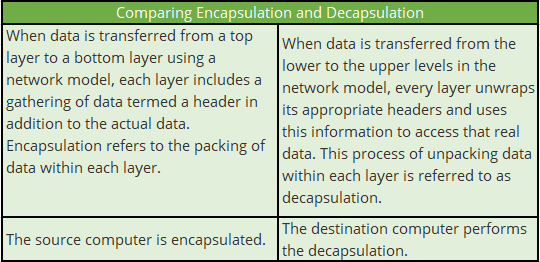All organizations depend on data for business projections. To keep it protected, it is vital to transfer data quickly and conveniently to safe place. The data can be transmitted via the network to the destination.
A network is a collection of connected devices, such as computers and printers, that are used to share resources. When a network has a significant number of hosts, the network grows complex, and the incompatibility between the computers increases. As a result, open standard network models have been enhanced.
The OSI and (TCP/IP) are two widely used network models. Trasmission Control Protocol/Internet Protocol is an improved system paradigm that is intended to take the place of the OSI model. Those models are multi-layered. Data is communicated via multiple layers of data communication. Encapsulation and decapsulation are two concepts that refer to the process of moving data across layers.
The critical distinction between encapsulation and decapsulation is that with encapsulation, data is transferred from an upper to a lower layer, and each layer contains a package of information referred to as a header in addition to the actual data.
The data is transferred from the base to the top ranks during decapsulation, and each layer unpacks the matching headers to access the real data.
Encapsulation – What Is It?
Standardization of network communication is accomplished through the usage of network models. When data is transferred from one area to another, it passes through a number of levels. The TCP/IP paradigm is comprised of four layers.
There are four layers in total:
- The application layer
- The transport layer
- The internet layer
- The network access layer.
Each layer has a distinct function in the TCP/IP model.
The application layer contains all end-user services such as email and web surfing. The transport layer is responsible for managing host-to-host communication. At the network layer, data is referred to as packets. It offers source and destination IP addresses, which aids in determining the network’s location.
Each device connected to the network is assigned an IP address. A packet is referred to as a frame at the network access layer. This layer assigns the source and destination MAC addresses to the packets received from the internet layer. The MAC address is equivalent to the physical address. Finally, the frame is transmitted away from the network.
Assume that you are sending an email. The application layer generates the email. Email should transit through the transport layer, the internet layer, and the network access layer in sequence, using various protocols and exiting a computer via a wireless or cable network interface.
The email is then routed via the network until it reaches its intended recipient. The email is then routed through the network access layer, the internet layer, the transport layer, and finally to the application layer.
Encapsulation is the process of adding information to the data transmitted from the application layer to each model layer. Each time data flows through a layer, it generates a new Protocol Data Unit (PDU) (PDU). In the transport layer, the data transferred from the application layer includes a header containing information about TCP/UDP.
The data is now referred to as a segment. When the segment reaches the internet layer, it receives an IP address header. It is now referred to as a package. When the packet reaches the network access layer, it receives a header containing MAC addresses.
It is currently referred to as a frame. Similarly, a Protocol Data Unit (PDU) is established for each tier. Encapsulation is the process of incorporating this information into each layer. The frame is then delivered to the network once the encapsulation procedure is complete.
Decapsulation – What Is It?
The frame exits the host computer and enters the network, as described in the encapsulation process. It then makes its way to the destination host. The frame is decapsulated in reverse order until it reaches the application layer on the destination host.
The frame that reaches the network access layer contains data, a TCP/UDP header, an IP header, and a MAC header.
When it is transmitted to the network layer, it is a packet having data, a TCP/UDP header, and an IP address header. The packet is then routed to the transport layer. It is now segmented and contains data in addition to the TCP/UDP header.
The segment then progresses to the application layer. The host can view the data sent from the source computer at the application layer. This is referred to as decapsulation.
Frequently Asked Questions
In the transport layer, what is encapsulation?
Are encapsulation and decapsulation the same thing?
What is the significance of encapsulation?
When it comes to networking, why is encapsulation so crucial?
Synopsis
A network is a collection of connected devices. These gadgets vary in appearance. This may result in incompatibility difficulties. To circumvent this, all devices on the network communicate using the normal network model.
TCP/IP is a popular network model. These models are composed of several layers. Each layer should be traversed before data is delivered to a new location. When the information reaches each layer, it is added to the data. This is referred to as encapsulation.
When the data reaches its destination, the additional information is unpacked in each layer. This is referred to as decapsulation. The distinction between encapsulation and decapsulation is that with encapsulation, data is transferred from an upper to a lower layer, and each layer has a collection of data called a header.
While the data is decapsulated, it is transferred from the lower to the top levels, where each layer unpacks the necessary headers to access the real data.
